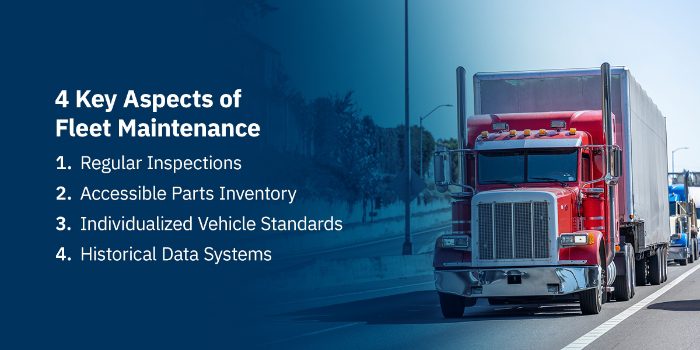
How to Create a Fleet Maintenance Program
Preventive fleet maintenance and management can allow your organization to adopt a more proactive approach to truck care and servicing. By staying ahead of complex problems, your trucks will maintain their quality and safety on the road.
What Is Fleet Maintenance?
Preventive fleet maintenance is a system of inspections, repairs and service that keeps your trucks functioning at their best. A proper fleet maintenance program is comprehensive and frequent, covering all systems and vehicles to catch problems early for better management and functionality.
This kind of program offers several advantages to your company’s fleet and operations, including:
- Increasing truck life span: When your trucks can function at their best and prevent long-term problems, they can stay in your fleet for longer. Your maintenance program can optimize functionality and longevity, so you can get the most from your investment. Regular maintenance identifies problems before they become too comprehensive to fix or cause strain on other components for healthier trucks that can withstand time.
- Reducing costs: Regular maintenance can identify problems early within your trucks, saving you money on repairs and service. Equipment and parts that function incorrectly can impact how well other components operate. Maintenance programs help ensure trucks efficiently receive care and scan for and reduce potential costly issues.
- Decreasing company liability: Breakdowns and accidents caused by ongoing problems and truck malfunctions can leave your company at fault for injuries, damages and failure to fulfill deliveries. Regular maintenance increases confidence in vehicles on the road, ensuring they can better protect your drivers, goods and other motorists. Functional trucks can protect your company’s finances and reputation for better relationships with your employees, partners and customers.
- Improving truck reliability and availability: When you can better understand each truck’s functionality and capabilities, you can rely on them when making deliveries. Your drivers can depend on their vehicles to get them to their destinations with fewer unexpected issues. Because regular maintenance can increase equipment’s useful life spans, more vehicles in your fleet can respond more efficiently as your business grows.

4 Key Aspects of Fleet Maintenance
When implementing a preventive maintenance program, you can develop a comprehensive and efficient system by understanding critical components.
1. Regular Inspections
To identify and address minor problems before they become more comprehensive and expensive issues, you must conduct regular inspections and tests on your trucks. These processes might include standard checks to ensure functionality you carry out at regular intervals, such as monthly or biweekly.
While many companies use on-site mechanics and technical teams to check their fleets, your drivers are excellent resources. Because they spend so much time in their vehicles, they know them best. Before and after runs, ask them to run minor functionality tests, so you can monitor progress and continue to identify problems as they occur.
2. Accessible Parts Inventory
Quick repairs and replacements are another essential part of a quality maintenance program. When you can efficiently solve problems, your maintenance system can better serve your fleet. A comprehensive inventory can help you implement your solutions to issues, so your trucks can get back on the road sooner.
3. Individualized Vehicle Standards
When creating a system for inspecting and testing your fleet, you must determine what qualifies as passing and failing. If you have a diverse fleet with several types and models of trucks, you’ll need to create standards for each model or truck. Your technicians and drivers can refer back to these resources to determine if trucks need servicing during regular testing.
4. Historical Data Systems
Records can help you identify patterns and individualized needs with historical data and reports. After receiving repairs or testing, your technicians and drivers should submit information to the proper sources. You can document these reports, so others can refer back to learn more about the maintenance trucks have received. With this information, you can determine if your efforts work or if trucks need to be retired.
4 Steps for Creating a Fleet Maintenance Program
A fleet maintenance program can benefit many organizations and their fleet management. If this option suits your company, you must know how to implement its various processes.
1. Determine Baseline Metrics
Regular maintenance and tests will rely on each truck’s capabilities and functionality. To mark a truck for repair or servicing, you need to know what qualifies as low performance or damage. As you implement this program, measure each truck’s performance and log their files so technicians, mechanics and drivers can access them. These metrics will help you track improvement and necessary maintenance.
2. Set Maintenance Intervals and Schedules
To identify problems early and efficiently, you must determine your vehicle maintenance schedule. You might institute a generalized interval for all trucks and specialized programs for those needing more care and attention. This aspect ensures you can identify problems and track truck performance with increased accuracy and consistency while building comprehensive historical data.
3. Develop Maintenance Checklists
When implementing a fleet maintenance program, your technicians need to know what to look for. Develop your program with checklists of what technicians and drivers should test and check with each interval and process.
For example, you might have more comprehensive annual tests that measure emissions, while monthly checkups look for component functionality and quality. If you require regular checks from drivers, you might include fundamental items, like windshield condition and headlight functionality.
Some components and functions you might want to check and test include:
- Engine oil and filters
- Transmission fluid
- Undercarriage and frame
- Interior and exterior lights
- Seat and belt
- Electrical systems and components
- Cooling and fueling systems and components
- Brake systems and components
- Steering and suspension systems and components
Your technicians might also look for corrosion and leaks, which can indicate other problems with the above systems and parts.
4. Establish Reporting and Tracking Systems
Part of your process requires creating records of maintenance requests and actions. These records provide essential information to several parties. Drivers can understand what changes technicians have made and request systems that allow them to report problems when they encounter them for increased efficiency. Technicians can review driver and other technician submissions to understand what to look for and use past reports to follow up on previous repairs.
Your records will be critical when measuring and charting maintenance system requests. You can see how regular maintenance impacts truck functionality by comparing historical data with repair requests. If requests have decreased since implementing new maintenance processes, you can conclude that your systems work.
Further Decrease Expenses With Bestpass
Comprehensive fleet maintenance is excellent when you want to reduce the cost of repairing and replacing trucks and their parts. When you want to decrease costs across your company and fleet, eliminating extraneous fees at tolls can help you continue to save money.
Bestpass is a payment platform for commercial fleets to help them manage toll payments. By organizing your entire fleet’s toll payments in one place, you can better understand overspending and implement cost-efficient strategies. We partner with several tolling authorities to increase accuracy and reduce unnecessary costs for more streamlined services and reliable record-keeping.
Contact Bestpass today to schedule a demo and discover how we can help your fleet manage and reduce costs.


